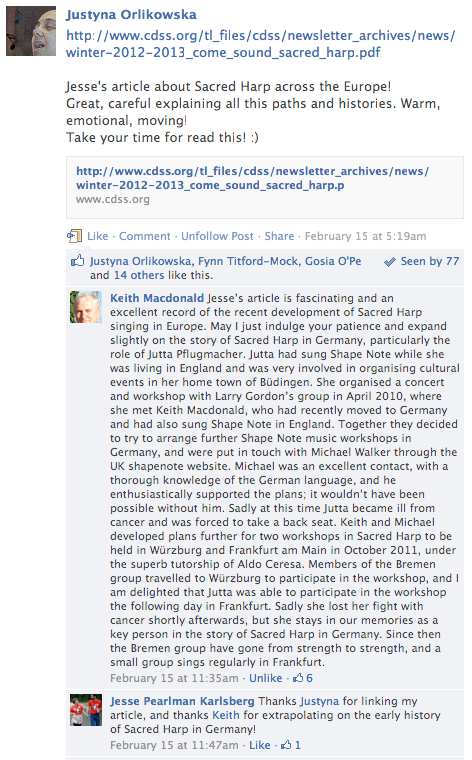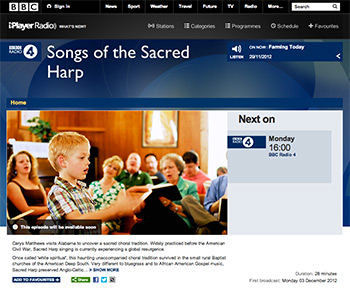In the wake of my trip last September to attend the seventeenth United Kindom and first Poland Sacred Harp Conventions and to teach at the first European session of Camp Fasola (held the week between these two conventions) I’ve continued to think and write about how Sacred Harp singers conceive of community, tradition, transmission, and place as the style spreads.

In November I wrote for the Country Dance and Song Society News on how these September singings “facilitate[d] cultural exchange, … inspire[d] community, and forge[d] emotional and spiritual connections” among European and North American singers. My essay, “‘Come Sound His Praise Abroad’: Sacred Harp Singing across Europe,” attempts to contextualize these recent events by recounting the introduction of this music to various European countries since 2008. In a comment on Facebook, Keith Maconald helpfully expanded on my account of the early history of Sacred Harp singing in Germany, pointing to the role he and the late Jutta Pflugmacher played in arranging for the Sacred Harp singing schools that Michael Walker and Aldo Ceresa held in Germany in October, 2011 (see screenshot from Facebook at right). I’ve transcribed a portion of Macdonald’s important comment below.
Jutta [Pflugmacher] had sung Shape Note while she was living in England and was very involved in organising cultural events in her home town of Büdingen. She organised a concert and workshop with Larry Gordon’s group in April 2010, where she met Keith Macdonald, who had recently moved to Germany and had also sung Shape Note in England. Together they decided to try to arrange further Shape Note music workshops in Germany, and were put in touch with Michael Walker through the UK shapenote website. Michael was an excellent contact, with a thorough knowledge of the German language, and he enthusiastically supported the plans; it wouldn’t have been possible without him. Sadly at this time Jutta became ill from cancer and was forced to take a back seat. Keith and Michael developed plans further for two workshops in Sacred Harp to be held in Würzburg and Frankfurt am Main in October 2011, under the superb tutorship of Aldo Ceresa. Members of the Bremen group travelled to Würzburg to participate in the workshop, and I am delighted that Jutta was able to participate in the workshop the following day in Frankfurt. Sadly she lost her fight with cancer shortly afterwards, but she stays in our memories as a key person in the story of Sacred Harp in Germany. Since then the Bremen group have gone from strength to strength, and a small group sings regularly in Frankfurt.
Michael Walker also touched on this early history in his essay on the October, 2011 German singing schools for the Sacred Harp Publishing Company Newsletter, “German Singing Schools: Sacred Harp Comes to the Land of J. S. Bach.”
In February I wrote for the Southern Spaces Blog on how the Sacred Harp events in Europe in September, 2012 “served as sites around which singers negotiated their associations of Sacred Harp singing with place.” My blog post—“Sacred Harp, ‘Poland Style’”—described how singers intentionally created what we described as a new “local tradition” of leading P. Dan Brittain’s song “Novakoski” with a time change from slow to moderate-fast at the start of the fuging section. The piece also noted how new singers from Poland and from Norwich in the United Kingdom have appropriated songs in The Sacred Harp bearing the names “Poland” and “Norwich” as symbols of their local Sacred Harp singing communities. My post was published the day before I left Georgia for another European singing trip, this time to Ireland for the third Ireland Sacred Harp Convention. Imagine my delight when the day after I arrived P. Dan told the story of “Novakoski,” “Polish Style” and led the song in the manner described above during his singing school the evening before the convention. Later, during the convention itself, a group of Polish singers led “Poland” and a group of singers from Norwich led “Norwich.” Quod erat demonstrandum.
Earlier in February I spoke about Sacred Harp in Europe at a conference titled “Southern Sounds/Out of Bounds: Music and the Global American South” held at the University of North Carolina, Chapel Hill and organized by the university’s Center for Global Initiatives and Center for the Study of the American South. My paper, “Digital Transmission and Mutable Tradition among European Sacred Harp Singers, 2008–2012,” addressed how European singers have supplemented transmission through travel to singings in the United States with reliance on digital resources such as YouTube videos shared through Facebook, and described how these singers are attempting to strike a balance between adhering to what they see as “traditional” practices while adapting Sacred Harp to new local contexts.
In addition to my two short essays and conference talk, two other short pieces on the Sacred Harp singing events in Europe last fall have recently been published. Gosia Perycz and Fynn Titford-Mock each contributed singing reviews on these three events to the Sacred Harp Publishing Company Newsletter. Their essays: “A Hollow Square in My Homeland: Bringing Camp Fasola to Poland” and “Celebrating Sacred Harp in Europe, September, 2012” describe the U.K. Convention, Camp Fasola Europe, and the Poland Convention in detail and are well worth a read.
